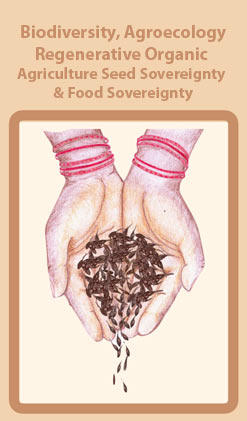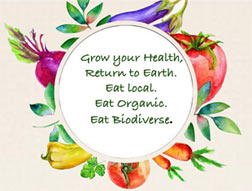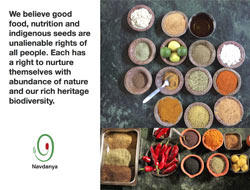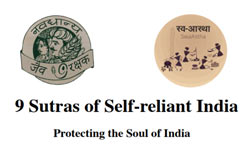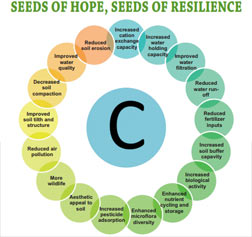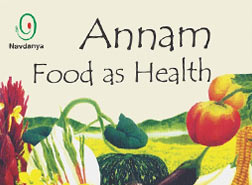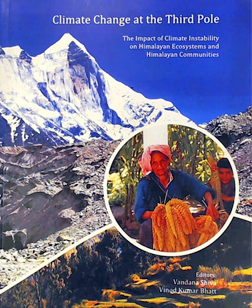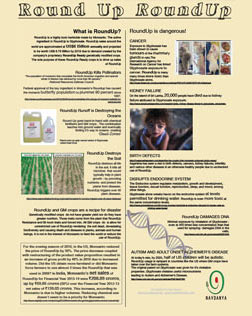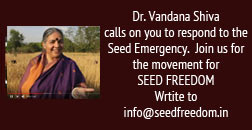Earth Democracy
Earth Democracy is both an ancient worldview and an emergent political movement for peace, justice, and sustainability. Earth Democracy connects the particular to the universal, the diverse to the common, and the local to the global. It incorporates what in India we refer to as vasudhaiva kutumbkam (the earth family) the community of the beings supported by the earth. Native American and indigenous cultures worldwide have understood and experienced life as a continuum between human and nonhuman species and between present, past and future generation.
Principles of earth Democracy
- All species, peoples, and cultures have intrinsic worth
All beings are subjects who have integrity, intelligence, and identity, not object of ownership, manipulation, exploitation, or disposability. No humans have the right to own other species, other people, or the knowledge of other cultures through patents and other intellectual property rights. - The earth community is a democracy of all life
We are all members of the earth family, interconnected through the planet’s fragile web of life. We all have a duty to live in a manner that protect the earth’s ecological processes, and the right and welfare of the species and all people. No humans have the right to encroach on the ecological space of the other species and other people, or to treat them with cruelty and violence. - Diversity in nature and culture must be defended
Biological and cultural diversity is an end in itself. Biological diversity is a value and a source of richness, both materially and culturally that creates conditions for sustainability. Cultural diversity creates the conditions for peace. Defending biological and cultural diversity is a duty of all people. - All beings have a natural right to sustenance
All member of the earth community, including all humans, have the right to sustenance to food and water, to a safe and clean habitat, to security of ecological space. Resources vital to sustenance must stay in the commons. The right to sustenance is a natural right because it is the right to life. These rights are not given by states or corporation, nor can they be extinguished by state or corporate action. No state or corporation has the right to erode or undermine these natural rights or enclose the commons that sustain life. - Earth Democracy is based on living economies and economic democracy
Earth democracy is based on economic democracy. Economic systems in Earth Democracy protect ecosystems and their integrity; they protect people’s livelihoods and provide basic needs to all. In the earth economy there are no disposable people or dispensable species or cultures. The earth economy is a living economy. It is based on sustainable, diverse, pluralistic systems that protect nature and people, are chosen by people, and work for the common good. And people, are chose by people, and work for the common good. - Living economies are built on local economies
Conservation of the earth’s resources and creation of sustainable and satisfying livelihoods are most caringly, creatively, efficiently, and equitably achieved at the local level. Localization of economies is a social and ecological imperative. Only goods and services that cannot be produced locally using local resources and local knowledge should be produced nonlocally and traded long distance. Earth Democracy is based on vibrant local economies, which support national and global economies. In Earth Democracy, the global economy does not destroy and crush local economies, nor does it create disposable people. Living economies recognize the creativity of all humans and create spaces for diverse creativities to reach their full potential. Living economies are divers and decentralized economies. - Earth Democracy is a living democracy
Living democracy is based on the democracy of all life and the democracy of everyday life. In living democracies people can influence the decisions over the food we eat, the water we drink, and the health care and education we have. Living democracy grows like a tree, from the bottom up. Earth Democracy is based on local democracy, with local communities organized on principles of inclusion, diversity, and ecological and social responsibility having the highest authority on decision related to the environment and natural resource and the sustenance and livelihoods of people. Authority is delegated to more distant level of governments on the principal of subsidiarity. Self-rule and self-governance is the foundation of the Earth Democracy. - Earth Democracy is based on living cultures
Living cultures promote peace and create free spaces for the practice of different religions and the adoption of different faiths and identities. Living cultures allow cultural diversity to thrive from the ground of our common humanity and our common rights as members of an earth community. - Living cultures are life nourishing
Living cultures are based on the dignity of and respect for all life, human and nonhuman, people of all genders and cultures, present and future generation. Living cultures are, therefore , ecological cultures which do not promote life-destroying lifestyles or consumption and production patterns, or the overuse and exploitation of resources. Living cultures are diverse and based on reverence for life. Living cultures recognize the multiplicity of identities based in an identity of place and local community and a planetary consciousness that connects the individual to the earth and all life. - Earth Democracy globalizes peace, care, and compassion
Earth Democracy connects people in circles of care, cooperation, and compassion instead of dividing them through competition and conflict, fear and hatred. In the face of a world of greed, inequality, and overconsumption, Earth Democracy globalizes compassion, justice, and sustainability.
POISON IN OUR FOOD
Fifty years ago Rachel Carson wrote Silent Spring. It was an early warning about the ecological impact of hazardous pesticide and chemicals. She noted the decrease in the number of birds and on investigation found that the eggs of the birds were not hatching. She established the link with this phenomenon to pesticides. Rachel Carson warned that spring associated with chirping of birds would be silent and beyond the birds, the pesticides and poisonous chemicals would affect humans too.
Over the past four decades, one has witnessed the increasing use of pesticides being promoted aggressively to farmers, vegetable and fruit growers, with no warnings about the adverse health effects associated with them. There has been systematic denial of unbiased information regarding the magnitude and the nature of acute, sub-acute and chronic poisoning due to pesticides. Farmers are never told about the effect on friendly, non-pest organisms and the emergence of pesticide resistance in the pests that they were allege to eliminate. Thus forcing repeated sprays resulted in increased costs as well as increased health hazards. It has always been propagated that these chemicals are safe and have been promoted as ‘medicine’ or ‘dawai’ for the crops. The aggressive unethical marketing by pesticide corporations, many of which also are in the business of pharmaceuticals and seeds, remains unchallenged by government agencies which are supposed to regulate them to protect people from harm.

